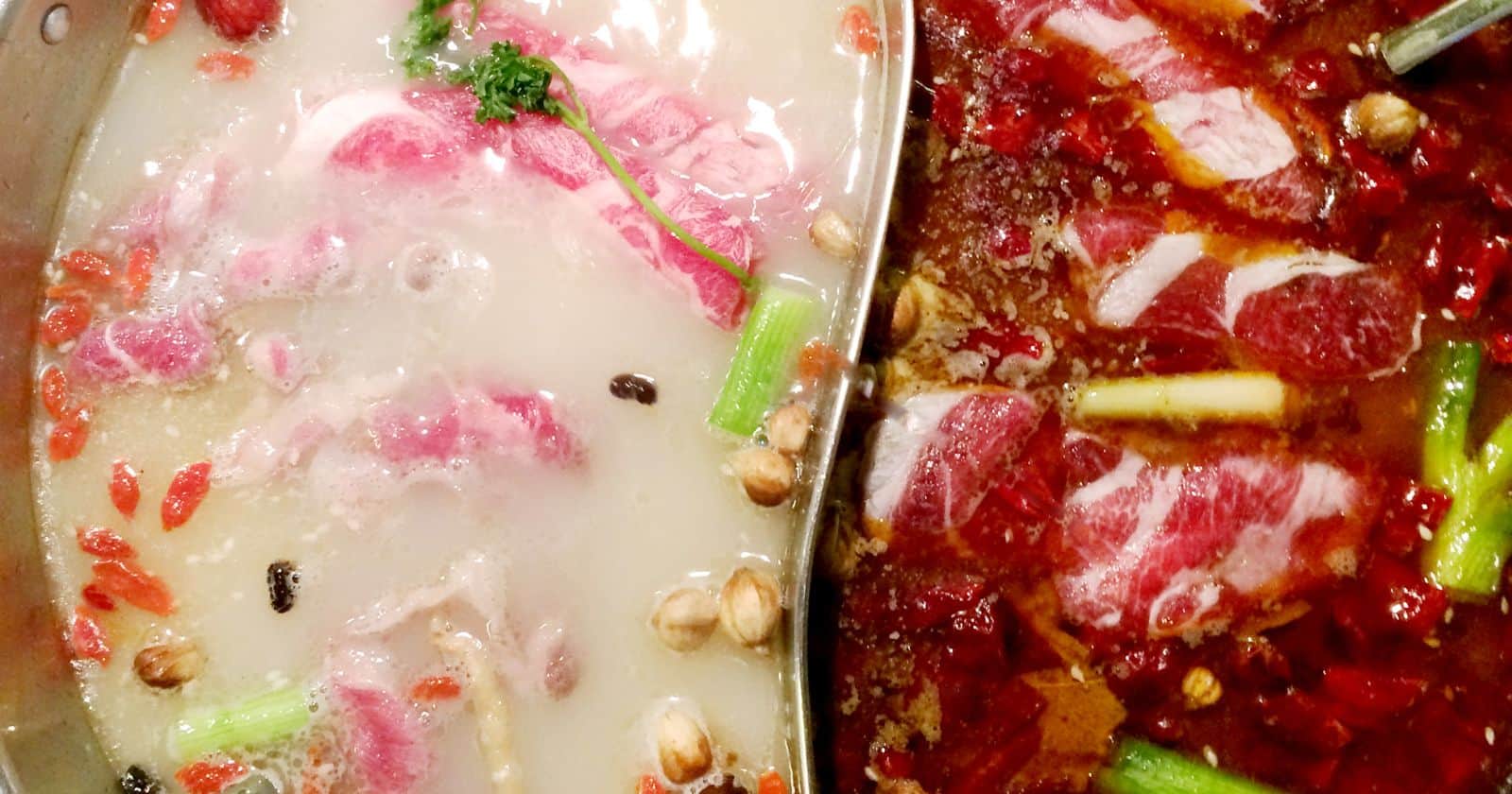Do you ever feel like you’re in a dinner rut? Tired of cooking the same old dishes and going to the same old restaurants? It’s time to shake up your mealtime routine with a uniquely interactive and flavorful dining experience – Mongolian hot pot.
Mongolian hot pot originated in China and has become popular across Asia and beyond. It features a communal pot of simmering broth placed in the center of the table. Diners then add their own choice of raw ingredients like thinly sliced meat, seafood, vegetables, mushrooms, noodles, and dumplings. The ingredients cook quickly in the broth, absorbing all the delicious flavors. Once cooked, you remove them from the pot and enjoy dipping the morsels in sauces like sesame sauce, chili oil, hoisin, and more.
Every hot pot meal is customizable to your taste. You control what you add to the pot and how long you cook it. The broth is often a savory bone broth with fiery chiles and warming spices. The array of dipping sauces allows you to further flavor each bite. It’s a hands-on, help-yourself style of eating that fosters camaraderie around the table.
If you’re seeking a dining experience that is interactive, customizable, and bursting with mouthwatering flavors, look no further than Mongolian hot pot. Read on to learn all about this sizzling sharing-style meal.
A Meal Full of Flavorful Surprises
The main event at a Mongolian hot pot gathering is the communal pot of bubbling broth. The broth serves as the flavor base for cooking the ingredients. It often contains:
- Bone broth – for body and an umami richness
- Spices – such as Sichuan peppercorns, star anise, cinnamon, fennel, and garlic
- Chiles and chili oil – for spicy heat
- Ginger and scallions – for aromatics
- Soy or oyster sauce – for savory depth
The broth is kept simmering at your table throughout the meal. The constant heat allows ingredients to cook quickly while absorbing the oils, spices, and full essence of the broth.
You control exactly what goes into the pot and how long it cooks. Platters of uncooked meats, vegetables, seafood, dumplings, noodles, and more will be presented. You choose what to dip and simmer in the broth until it’s cooked to your liking.
Some favorite hot pot ingredients include:
- Thinly sliced beef and lamb
- Fish balls and fish cakes
- Fresh shrimp, scallops, squid, and crab
- Tofu, mushrooms, spinach, and bok choy
- Dumplings and wontons
- Rice noodles, glass noodles, and egg noodles
- Napa cabbage, yam, and sweet potato
The raw ingredients partially cook extremely quickly in the simmering broth – usually in 1-2 minutes. Once cooked, use a slotted spoon to transfer them to your individual dipping bowl.
Flavor, Texture, and Aroma – Oh My!
Mongolian hot pot is a multi-sensory experience. The bubbling broth oozes with aromas of garlic, ginger, and chiles. Plunging ingredients into the simmering pot allows them to absorb the full richness of flavors.
Different textures also come into play. The broth leaves meats fork-tender while still allowing crunchier items like bok choy and napa cabbage to retain their crispness. Glass noodles and rice noodles soften into slippery, chewy strands.
Once in your personal dipping bowl, you can further accentuate the flavors and textures using an array of sauces and condiments.
Popular hot pot dipping sauces include:
- Sesame sauce – A savory, nutty sauce sometimes mixed with peanut butter or sesame paste.
- Chili oil – Infused with dried chiles and often garlic, shallots, or scallions. Provides a glowing heat.
- Soy sauce – For saltiness and umami. Ponzu sauce also provides citrusy accents.
- Hoisin sauce – Sweet and salty sauce thickened with starch.
- Garlic sauce – Minced garlic blended into a thick paste.
- Vinegar – Rice vinegar or black vinegar enhance acidity.
- Chili sauce – From mild garlic chili sauce to the sinus-clearing heat of Sichuan chili sauce.
You can go minimalist with just a dip in soy or sesame sauce. Or amp up the layers of flavor by blending sauces and condiments. It’s another way you customize each bite to suit your personal tastes.
How to Host a Hot Pot House Party
Supplies You’ll Need
To host a successful hot pot gathering at home you’ll need:
- A hot pot cooker – This can be a simple electric cooker or more elaborate set-up with individual pots. Have one pot for every 4 people.
- Broth – Chicken, beef, or vegetable broth flavored as desired. Bring to a simmer before guests arrive.
- Plates and bowls – For diners to use as they cook and dip ingredients. Chopsticks and soup spoons work well.
- Ingredients – An array of meats, seafood, veggies, noodles etc. Thinly sliced.
- Sauces – Provide several dipping sauce options in small bowls for sharing.
Optional supplies:
- Portable burner or hot plates – To keep broth simmering at the table.
- Strainer or slotted spoon – For transferring cooked items into dipping bowls.
- Ladle – For replenishing broth as needed.
- Spice paste or chili oil – To allow guests to adjust broth spiciness themselves.
Tips for Hosting Hot Pot
Here are some tips to ensure hot pot is a success at your gathering:
- Partially cook meats in advance – Thinly sliced meats will cook quickly in the broth. Half cook meats like chicken and beef beforehand so they don’t overcook.
- Slice ingredients thinly – Cut all ingredients into thin, uniform pieces so they cook rapidly.
- Divide proteins and veggies – Allow guests to take manageable amounts of ingredients at a time. Avoid crowding the pot.
- Adjust broth as needed – Keep some extra seasoned broth simmering on a burner to replenish the pot as needed.
- Let guests season individually– Allow guests to season cooked items themselves with sauces rather than seasoning the broth.
- Set out sauces in advance – Arrange dipping sauce bowls and condiments at the table before guests arrive.
- Go bite by bite – Instruct guests to wait and eat one ingredient at a time rather than overfilling bowls.
- Control cooking times – Advise guests on approximate cooking times to avoid over or undercooking.
- Keep ingredients separate – Remind guests to use different utensils for raw and cooked foods to avoid cross-contamination.
Bring the Interactive Fun of Hot Pot Home
Hot pot is meant to be a leisurely, communal dining experience shared with family and friends. At a restaurant, you miss out on the intimacy of cooking and creating the meal together around your own table.
Hosting hot pot at home is easy and fun. Assign tasks – one friend can slice meats and veggies, another can prep sauces, and someone else can monitor the broth. The hands-on process makes everyone feel a part of the action.
Kids also love getting involved in picking ingredients and stirring the pot. Order isn’t crucial – just focus on cooking, dipping, savoring the flavors, and enjoying the togetherness.
Focus more on having fun than following strict rules or etiquette. Turn up some lively music in the background to complement the bubbly sounds of the simmering broth.
When each person can customize their own experience, Mongolian hot pot is a versatile meal that satisfies all tastes – vegetarians, meat lovers,
The only limits are your own imagination. Change up broth bases, meat selections, veggies, dipping sauces, and more to invent your own hot pot recipes.
Try hot pot for a dining experience that sizzles with possibility. The hands-on cooking engages everyone at the table and allows you to tailor each morsel to your personal palate.
Dig into this interactive, communal meal on your next game night, birthday gathering, or any time you long to try something different for dinner. Just brace yourself for the addictive flavors – hot pot may become your new favorite food tradition.





